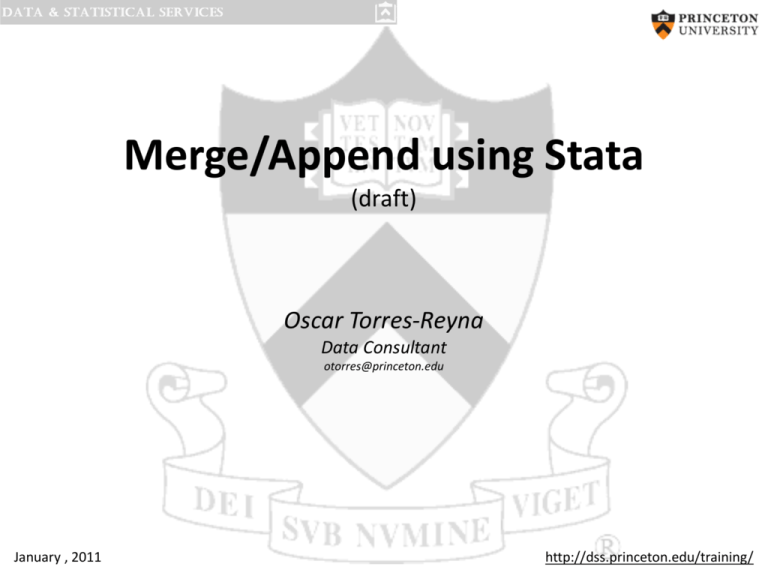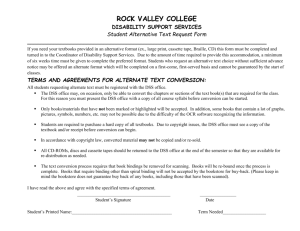
Merge/Append using Stata
(draft)
Oscar Torres-Reyna
Data Consultant
otorres@princeton.edu
January , 2011
http://dss.princeton.edu/training/
Intro
Merge – adds variables to a dataset. Type help merge for details.
Merging two datasets require that both have at least one variable in common (either
string or numeric). If string make sure the categories have the same spelling (i.e.
country names, etc.).
The common variables must have the same name.
Explore each dataset separately before merging. Make sure to use all possible
common variables (for example, if merging two panel datasets you will need country
and years).
Append – adds cases/observations to a dataset. Type help append for details.
Appending two datasets require that both have variables with exactly the same name.
If using categorical data make sure the categories on both datasets refer to exactly
the same thing (i.e. 1 “Agree”, 2”Disagree”, 3 “DK” on both). Remember that Stata is
case sensitive, 'Year' is not the same as 'year'. For variables that do not match, Stata
will add missing values.
PU/DSS/OTR
2
MERGE – EXAMPLE 1 (type help merge for more details)
mydata1
mydata2
merge 1:1 country year using mydata2
•
Result
# of obs.
----------------------------------------not matched
0
matched
12 (_merge==3)
-----------------------------------------
*To set the working directory see here
http://dss.princeton.edu/training/StataTutorial.pdf#page=6
Make sure one dataset is loaded into Stata (in this case mydata1),
then use merge.
• Make sure to map where the using data is located (in this case
mydata2, for example “c:\folders\data\mydata2.dta”)*.
NOTE: For Stata 10 or older:
1) Remove the 1:1
2) Sort both datasets by all the ids and save before merging
PU/DSS/OTR
3
MERGE – EXAMPLE 2 (one dataset missing a country)
mydata1
mydata3
•
merge 1:1 country year using mydata3
•
Result
# of obs.
----------------------------------------not matched
4
from master
4 (_merge==1)
from using
0 (_merge==2)
matched
8
-----------------------------------------
*To set the working directory see here
http://dss.princeton.edu/training/StataTutorial.pdf#page=6
(_merge==3)
•
Make sure one dataset is loaded into Stata (in this case mydata1), then
use merge.
Make sure to map where the using data is located (in this case mydata2,
for example “c:\folders\data\mydata3.dta”)*.
Unmatched data is set to missing. If you want to keep only matched data,
you can type
keep if _merge==3
NOTE: For Stata 10 or older:
1) Remove the 1:1
2) Sort both datasets by all the ids and save before merging
PU/DSS/OTR
4
MERGE – EXAMPLE 3 (many to one)
mydata1
mydata4
•
merge m:1 country using mydata4
•
Result
# of obs.
----------------------------------------not matched
0
matched
12 (_merge==3)
-----------------------------------------
*To set the working directory see here
http://dss.princeton.edu/training/StataTutorial.pdf#page=6
PU/DSS/OTR
Make sure one dataset is loaded into Stata (in this case mydata1),
then use merge.
Make sure to map where the using data is located (in this case
mydata2, for example “c:\folders\data\mydata4.dta”)*.
NOTE: For Stata 10 or older:
1) Remove the m:1
2) Sort both datasets by all the ids and save before merging
5
APPEND
PU/DSS/OTR
6
APPEND– EXAMPLE 1
mydata7
•
•
Make sure one dataset is loaded into Stata (in this case
mydata7), then use append.
Make sure to map where the using data is located (in this
case mydata2, for example “c:\folders\data\mydata8.dta”)*.
append using mydata8
mydata8
*To set the working directory see here
http://dss.princeton.edu/training/StataTutorial.pdf#page=6
PU/DSS/OTR
7
APPEND – EXAMPLE 1 (cont.) – sorting by country/year
sort country year
PU/DSS/OTR
8
APPEND– EXAMPLE 2 (one dataset missing one variable)
mydata7
•
Make sure one dataset is loaded into Stata (in this case
mydata7), then use append.
•
Make sure to map where the using data is located (in this
case mydata2, for example “c:\folders\data\mydata9.dta”)*.
•
Notice the missing data.
append using mydata9
mydata9
*To set the working directory see here
http://dss.princeton.edu/training/StataTutorial.pdf#page=6
PU/DSS/OTR
9
Useful links / Recommended books
•
DSS Online Training Section http://dss.princeton.edu/training/
•
UCLA Resources to learn and use STATA http://www.ats.ucla.edu/stat/stata/
•
DSS help-sheets for STATA http://dss/online_help/stats_packages/stata/stata.htm
•
Introduction to Stata (PDF), Christopher F. Baum, Boston College, USA. “A 67-page description of Stata, its key
features and benefits, and other useful information.” http://fmwww.bc.edu/GStat/docs/StataIntro.pdf
•
STATA FAQ website http://stata.com/support/faqs/
•
Princeton DSS Libguides http://libguides.princeton.edu/dss
Books
•
Introduction to econometrics / James H. Stock, Mark W. Watson. 2nd ed., Boston: Pearson Addison
Wesley, 2007.
•
Data analysis using regression and multilevel/hierarchical models / Andrew Gelman, Jennifer Hill.
Cambridge ; New York : Cambridge University Press, 2007.
•
Econometric analysis / William H. Greene. 6th ed., Upper Saddle River, N.J. : Prentice Hall, 2008.
•
Designing Social Inquiry: Scientific Inference in Qualitative Research / Gary King, Robert O.
Keohane, Sidney Verba, Princeton University Press, 1994.
•
Unifying Political Methodology: The Likelihood Theory of Statistical Inference / Gary King, Cambridge
University Press, 1989
•
Statistical Analysis: an interdisciplinary introduction to univariate & multivariate methods / Sam
Kachigan, New York : Radius Press, c1986
•
Statistics with Stata (updated for version 9) / Lawrence Hamilton, Thomson Books/Cole, 2006






